High-Temperature Rheological Properties of Asphalt Mortar Modified with Spent FCC Catalysts
Abstract
:1. Introduction
2. Experimental
2.1. Materials
2.2. Preparation of S-FCC-C-Modified Asphalt Slurry
2.3. Test Method
3. Results and Discussion
3.1. Temperature Scan Test Results
3.2. MSCR
4. Conclusions
- (1)
- At the same test temperature, the phase angle of S-FCC-C-modified asphalt slurry decreases, and the rutting factor increases with an increase in the S-FCC-C replacement dose, leading to a significant enhancement in the high-temperature performance of the modified asphalt slurry.
- (2)
- With the same dose, the phase angle of the S-FCC-C-modified asphalt slurry increases, and the rutting factor decreases as the test temperature rises. This results in a decrease in the high-temperature performance of the modified asphalt slurry, although it remains superior to limestone powder asphalt slurry.
- (3)
- The deformation recovery rates R0.1 and R3.2 increase as the S-FCC-C replacement admixture increases, leading to a substantial improvement in high-temperature performance, particularly at an 80% replacement admixture. Meanwhile, the average non-recoverable creep flexibilities Jnr0.1 and Jnr3.2 decrease, with a higher decrease rate observed at low dosing compared to high dosing. This signifies a significant enhancement in the recovery deformation capacity of the asphalt mastic at low S-FCC-C dosing, which gradually diminishes at higher dosing.
- (4)
- The alternative admixture of S-FCC-C enhances the filling effect of the filler in the asphalt mastic, resulting in a reversed increase in stress sensitivity at higher admixtures (negative Jnr-diff values). A 20% alternative admixture of HC, SL, and JX samples improves the stress sensitivity of mineral powder asphalt mastic. Therefore, 20% represents the optimal alternative admixture for HC, SL, and JX samples.
- (5)
- The asphalt mortar filled with JX exhibited the best rutting resistance and resilience performance among the five S-FCC-C asphalt mortars, suggesting that the surface area and hydrophilic coefficient of S-FCC-Cs co-affect the high-temperature rheological performance of asphalt mortar. Considering stress sensitivity, the use of JX can be recommended to replace 20% of mineral powder in the aggregate in the pavement construction.
Author Contributions
Funding
Institutional Review Board Statement
Informed Consent Statement
Data Availability Statement
Conflicts of Interest
References
- Vishnu, T.B.; Singh, K.L. A study on the suitability of solid waste materials in pavement construction: A review. Int. J. Pavement Res. Technol. 2020, 14, 625–637. [Google Scholar] [CrossRef]
- Tao, G.; Xiao, Y.; Yang, L.; Cui, P.; Kong, D.; Xue, Y. Characteristics of steel slag filler and its influence on rheological properties of asphalt mortar. Constr. Build. Mater. 2019, 201, 439–446. [Google Scholar] [CrossRef]
- Li, C.; Wang, H.; Fu, C.; Shi, S.; Liu, Q.; Xu, P.; Liu, Q.; Zhou, D.; Cheng, Y.; Jiang, L. Effect and mechanism of waste glass powder silane modification on water stability of asphalt mixture. Constr. Build. Mater. 2023, 366, 130086. [Google Scholar] [CrossRef]
- Zheng, Y.; Chen, S.; Huang, W.; Cai, X.; Huang, J.; Wu, K. Principle analysis of the mix design and performance evaluation of the asphalt-filler volume equivalent substitution method. Constr. Build. Mater. 2023, 367, 130276. [Google Scholar] [CrossRef]
- Skaf, M.; Manso, J.M.; Aragón, Á.; Fuente-Alonso, J.A.; Ortega-López, V. EAF slag in asphalt mixes: A brief review of its possible reuse. Resour. Conserv. Recycl. 2017, 120, 176–185. [Google Scholar] [CrossRef]
- Hamzani; Munirwansyah; Hasan, M.; Sugiarto, S. Determining the properties of semi-flexible pavement using waste tire rubber powder and natural zeolite. Constr. Build. Mater. 2021, 266, 121199. [Google Scholar] [CrossRef]
- Wang, Q.; Wang, N.; Tseng, M.; Huang, Y.; Li, N. Waste tire recycling assessment: Road application potential and carbon emissions reduction analysis of crumb rubber modified asphalt in China. J. Clean. Prod. 2020, 249, 119411. [Google Scholar] [CrossRef]
- Ferella, F.; Innocenzi, V.; Maggiore, F. Oil refining spent catalysts: A review of possible recycling technologies. Resour. Conserv. Recycl. 2016, 108, 10–20. [Google Scholar] [CrossRef]
- Kanduri, K.P.; Seethamraju, S. Effect of process mode on product yields and selectivity in the catalytic co-pyrolysis of peanut shells and polypropylene using spent fluid catalytic cracking (FCC) catalyst. Bioresour. Technol. Rep. 2023, 22, 101478. [Google Scholar] [CrossRef]
- Mavukwana, A.; Burra, K.G.; Sempuga, C.; Castaldi, M.; Gupta, A.K. Effect of spent fluid catalytic cracking (FCC) catalyst on syngas production from pyrolysis and CO2-assisted gasification of waste tires. Fuel 2024, 355, 129446. [Google Scholar] [CrossRef]
- Su, B.; Shi, L.; Meng, X.; Wang, X.; Liu, N. From waste to best: Excellent desulfurization performance of spent FCC catalyst. J. Sulfur Chem. 2019, 40, 75–87. [Google Scholar] [CrossRef]
- Al-Jabri, K.; Baawain, M.; Taha, R.; Al-Kamyani, Z.S.; Al-Shamsi, K.; Ishtieh, A. Potential use of FCC spent catalyst as partial replacement of cement or sand in cement mortars. Constr. Build. Mater. 2013, 39, 77–81. [Google Scholar] [CrossRef]
- Velázquez, S.; Monzó, J.; Borrachero, M.V.; Soriano, L.; Payá, J. Evaluation of the pozzolanic activity of spent FCC catalyst/fly ash mixtures in Portland cement pastes. Thermochim. Acta 2016, 632, 29–36. [Google Scholar] [CrossRef]
- Liu, C.; Cui, J.; Zhang, Z.; Liu, H.; Huang, X.; Zhang, C. The role of TBM asymmetric tail-grouting on surface settlement in coarse-grained soils of urban area: Field tests and FEA modelling. Tunn. Undergr. Space Technol. 2021, 111, 103857. [Google Scholar] [CrossRef]
- Qiu, R.; Wang, W.; Wang, Z.; Wang, H. Advancement of modification engineering in lean methane combustion catalysts based on defect chemistry. Catal. Sci. Technol. 2023, 13, 2566–2584. [Google Scholar] [CrossRef]
- Alshamsi, K.; Baawain, M.; Aljabri, K.; Taha, R.; Al-kamyani, Z. Utilizing waste spent catalyst in asphalt mixtures. Procedia Soc. Behav. Sci. 2012, 53, 326–334. [Google Scholar] [CrossRef]
- Liu, H.; He, H.; Li, Y.; Hu, T.; Ni, H.; Zhang, H. Coupling effect of steel slag in preparation of calcium-containing geopolymers with spent fluid catalytic cracking (FCC) catalyst. Constr. Build. Mater. 2021, 290, 123194. [Google Scholar] [CrossRef]
- Tian, X.; Han, S.; Wang, K.; Shan, T.; Li, Z.; Li, S.; Wang, C. Waste resource utilization: Spent FCC catalyst-based composite catalyst for waste tire pyrolysis. Fuel 2022, 328, 125236. [Google Scholar] [CrossRef]
- Mymrin, V.; Pedroso, A.M.; Ponte, H.A.; Ponte, M.J.J.; Alekseev, K.; Evaniki, D.; Pan, R.C.Y. Thermal engineering method application for hazardous spent petrochemical catalyst neutralization. Appl. Therm. Eng. 2017, 110, 1428–1436. [Google Scholar] [CrossRef]
- Taha, R.; Al-Kamyani, Z.; Al-Jabri, K.; Baawain, M.; Al-Shamsi, K. Recycling of waste spent catalyst in road construction and masonry blocks. J. Hazard. Mater. 2012, 229–230, 122–127. [Google Scholar] [CrossRef]
- Basaldella, E.I.; Torres Sánchez, R.M.; Conconi, M.S. Conversion of exhausted fluid cracking catalysts into zeolites by alkaline fusion. Appl. Clay Sci. 2009, 42, 611–614. [Google Scholar] [CrossRef]
- Chen, H.; Tseng, Y.; Hsu, K. Spent FCC catalyst as a pozzolanic material for high-performance mortars. Cem. Concr. Compos. 2004, 26, 657–664. [Google Scholar] [CrossRef]
- Rodríguez, E.D.; Bernal, S.A.; Provis, J.L.; Gehman, J.D.; Monzó, J.M.; Payá, J.; Borrachero, M.V. Geopolymers based on spent catalyst residue from a fluid catalytic cracking (FCC) process. Fuel 2013, 109, 493–502. [Google Scholar] [CrossRef]
- Alsheyab, M.A.T.; Khedaywi, T.S.; Elayan, M.S. Laboratory study on solidification/stabilization of unwanted medications using asphalt as a binder. J. Mater. Cycles Waste Manag. 2012, 15, 129–137. [Google Scholar] [CrossRef]
- Cervinkova, M.; Vondruska, M.; Bednarik, V.; Pazdera, A. Stabilization/solidification of munition destruction waste by asphalt emulsion. J. Hazard. Mater. 2007, 142, 222–226. [Google Scholar] [CrossRef]
- Furimsky, E. Spent refinery catalysts: Environment, safety and utilization. Catal. Today 1996, 30, 223–286. [Google Scholar] [CrossRef]
- Schmitt, R. FCC catalyst finds three safe reuse outlets in Europe. Oil Gas J. 1991, 89, 46. [Google Scholar]
- Wai, C.M.; Frye, J.G.; Fulton, J.L.; Bowman, L.E.; Silva, L.J.; Gerber, M.A. Regeneration of Hydrotreating and FCC Catalysts; Pacific Northwest National Lab (PNNL): Richland, WA, USA, 1999. [Google Scholar] [CrossRef]
- Akisetty, C.; Xiao, F.; Gandhi, T.; Amirkhanian, S. Estimating correlations between rheological and engineering properties of rubberized asphalt concrete mixtures containing warm mix asphalt additive. Constr. Build. Mater. 2011, 25, 950–956. [Google Scholar] [CrossRef]
- Dong, F.; Zu, Y.; Chen, B.; Yu, X.; Huang, J. Laboratory investigations of the effects of asphalt mortar and its viscoelasticity on the workability of asphalt mixtures. Constr. Build. Mater. 2023, 389, 131756. [Google Scholar] [CrossRef]
- Lu, G.; Lu, X.; Liu, P. Reactivation of spent FCC catalyst by mixed acid leaching for efficient catalytic cracking. J. Ind. Eng. Chem. 2020, 92, 236–242. [Google Scholar] [CrossRef]
- Xue, Y.; Wei, X.; Zhao, H.; Wang, T.; Xiao, Y. Interaction of spent FCC catalyst and asphalt binder: Rheological properties, emission of VOCs and immobilization of metals. J. Clean. Prod. 2020, 259, 120830. [Google Scholar] [CrossRef]
- JTG E42-2005; Test Procedure for Aggregates in Highway Engineering. Chinese Professional Standard. Ministry of Transport of the People’s Republic of China: Beijing, China, 2005.
- JTG F40-2004; Technical Specification for Highway Asphalt Pavement Construction. Chinese Professional Standard. Ministry of Transport of the People’s Republic of China: Beijing, China, 2004.
- D’Angelo, J.; Dongré, R. Practical use of multiple stress creep and recovery test: Characterization of Styrene–Butadiene–Styrene dispersion and other additives in Polymer-Modified asphalt binders. Transp. Res. Rec. 2009, 2126, 73–82. [Google Scholar] [CrossRef]
- Wang, N.; Li, C.; Xu, C. Effect of basalt fibers on rheological property of asphalt mortar. Adv. Mater. Res. 2015, 1095, 233–236. [Google Scholar] [CrossRef]
- Liu, G.; Yang, T.; Li, J.; Jia, Y.; Zhao, Y.; Zhang, J. Effects of aging on rheological properties of asphalt materials and asphalt-filler interaction ability. Constr. Build. Mater. 2018, 168, 501–511. [Google Scholar] [CrossRef]
- Cui, L.; Xu, J.; Cen, L.; Ren, M.; Cao, F. Molecular engineering and modification of FCC slurry oil residue for improving ageing resistance of high quality paving asphalt. Constr. Build. Mater. 2021, 299, 124234. [Google Scholar] [CrossRef]
- Han, S.; Sun, P.; Fwa, T.F. Relationships between internal structure and surface texture of asphalt mixtures. Road Mater. Pavement Des. 2019, 22, 894–909. [Google Scholar] [CrossRef]
- Harris, F.A. Asphalt membranes in expressway construction. Transp. Res. Board Natl. Acad. Sci. 1963, 7, 34–46. [Google Scholar]
- Cao, K.; Xu, W.; Chen, D.; Feng, H. High-and low-temperature properties and thermal stability of silica fume/SBS composite-modified asphalt mortar. Adv. Mater. Sci. Eng. 2018, 2018, 1317436. [Google Scholar]
- Ling, C.; Arshadi, A.; Bahia, H. Importance of binder modification type and aggregate structure on rutting resistance of asphalt mixtures using image-based multi-scale modelling. Road Mater. Pavement Des. 2016, 18, 785–799. [Google Scholar] [CrossRef]
- Zulkati, A.; Diew, W.Y.; Delai, D. Effects of fillers on properties of asphalt-concrete mixture. J. Transp. Eng. ASCE 2012, 138, 902–910. [Google Scholar] [CrossRef]
- Guo, M.; Bhasin, A.; Tan, Y. Effect of mineral fillers adsorption on rheological and chemical properties of asphalt binder. Constr. Build. Mater. 2017, 141, 152–159. [Google Scholar] [CrossRef]
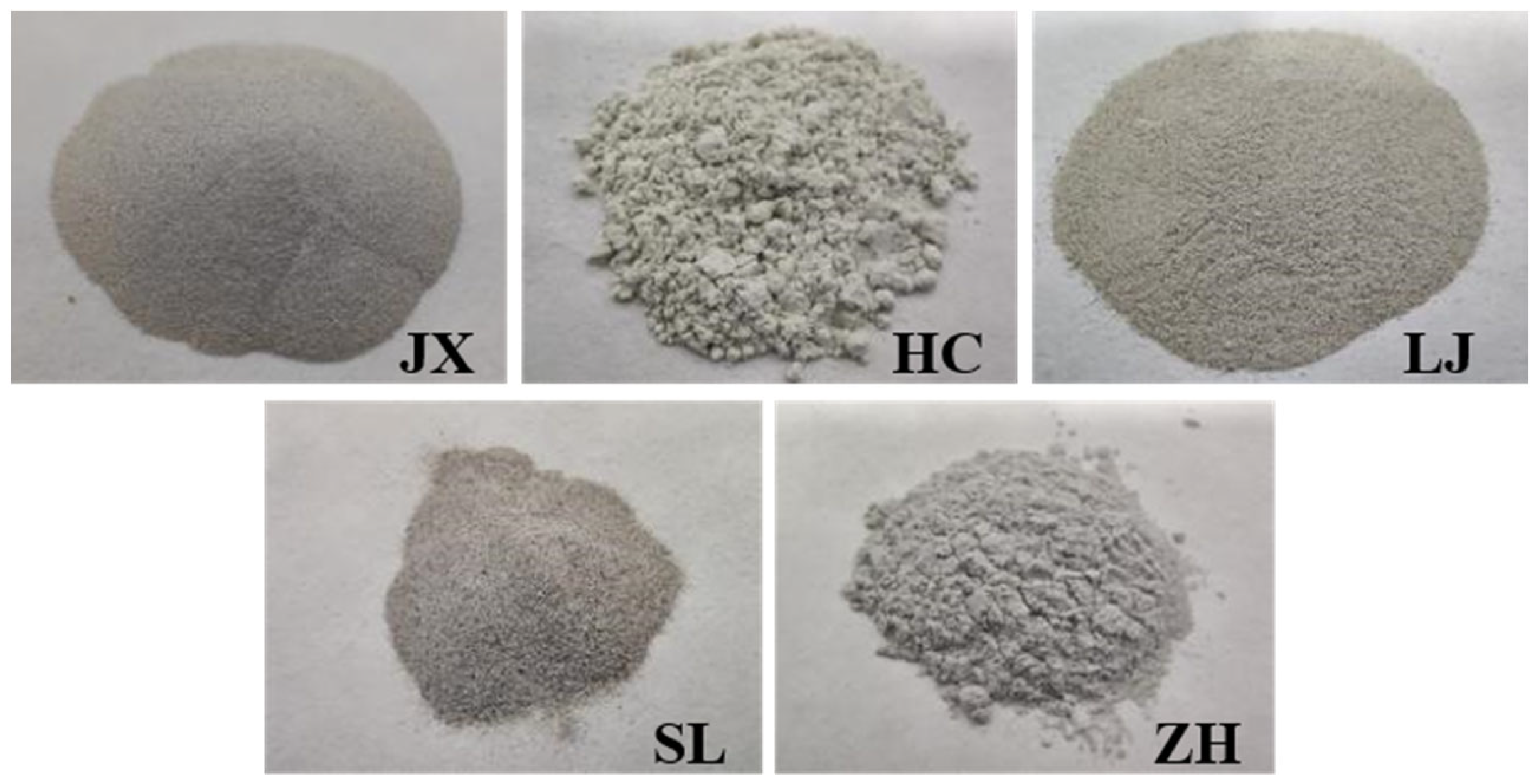
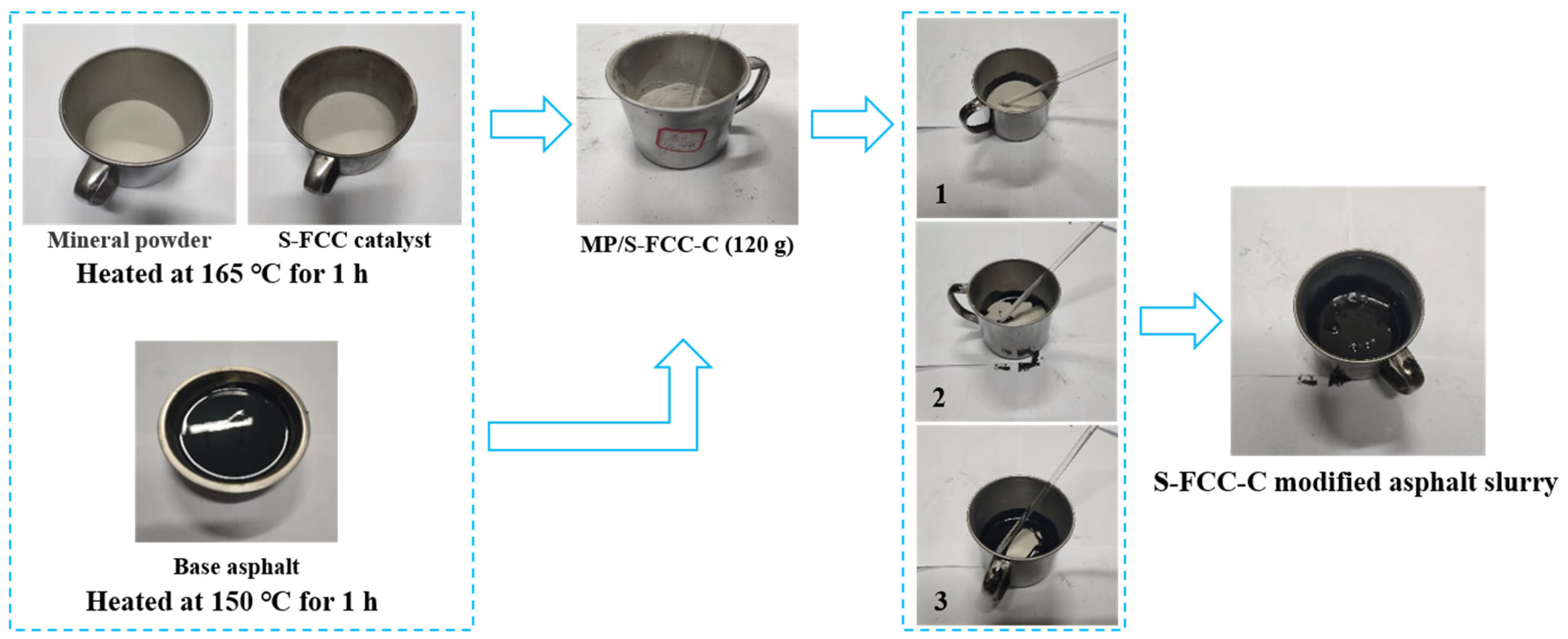
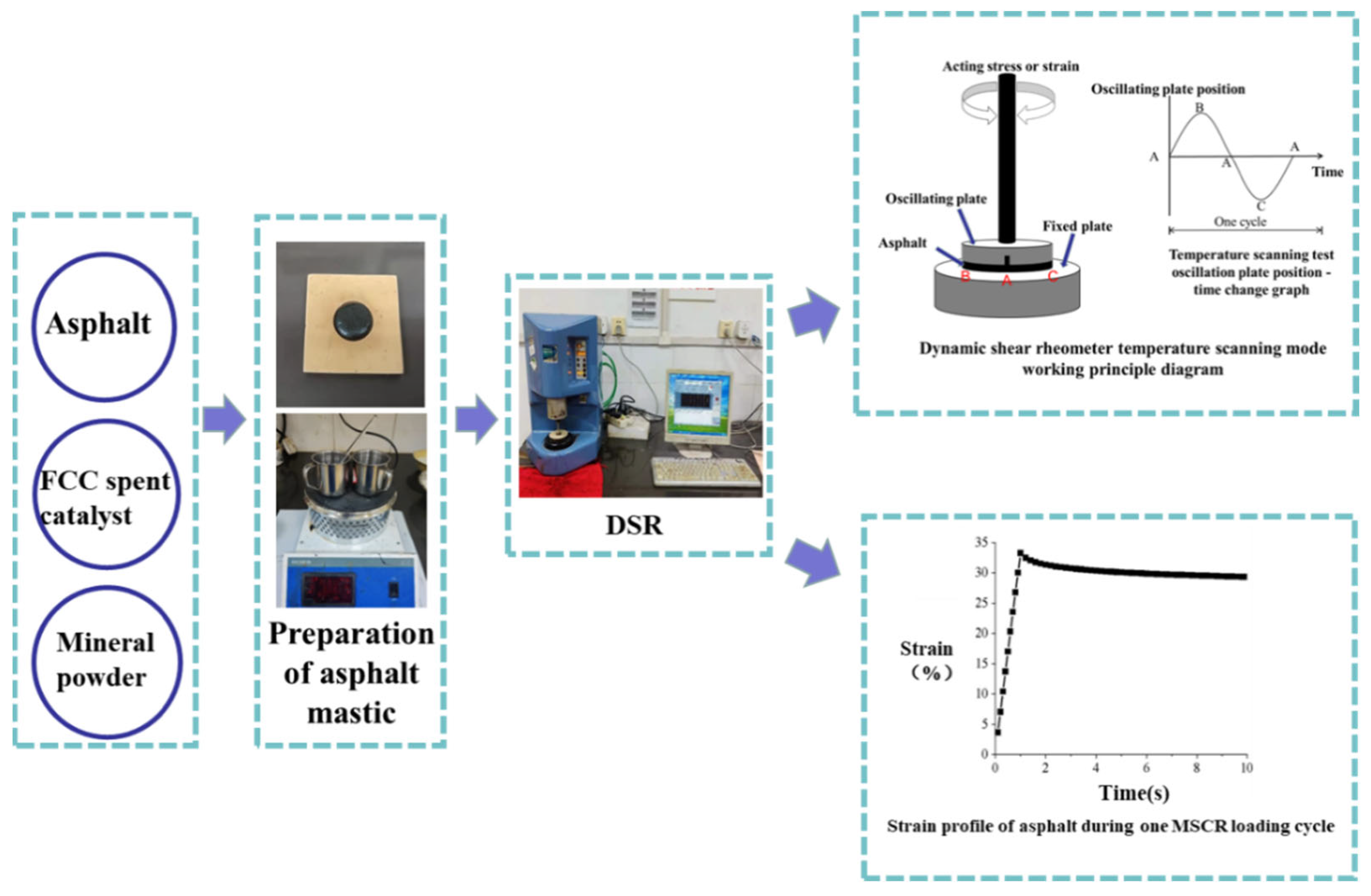
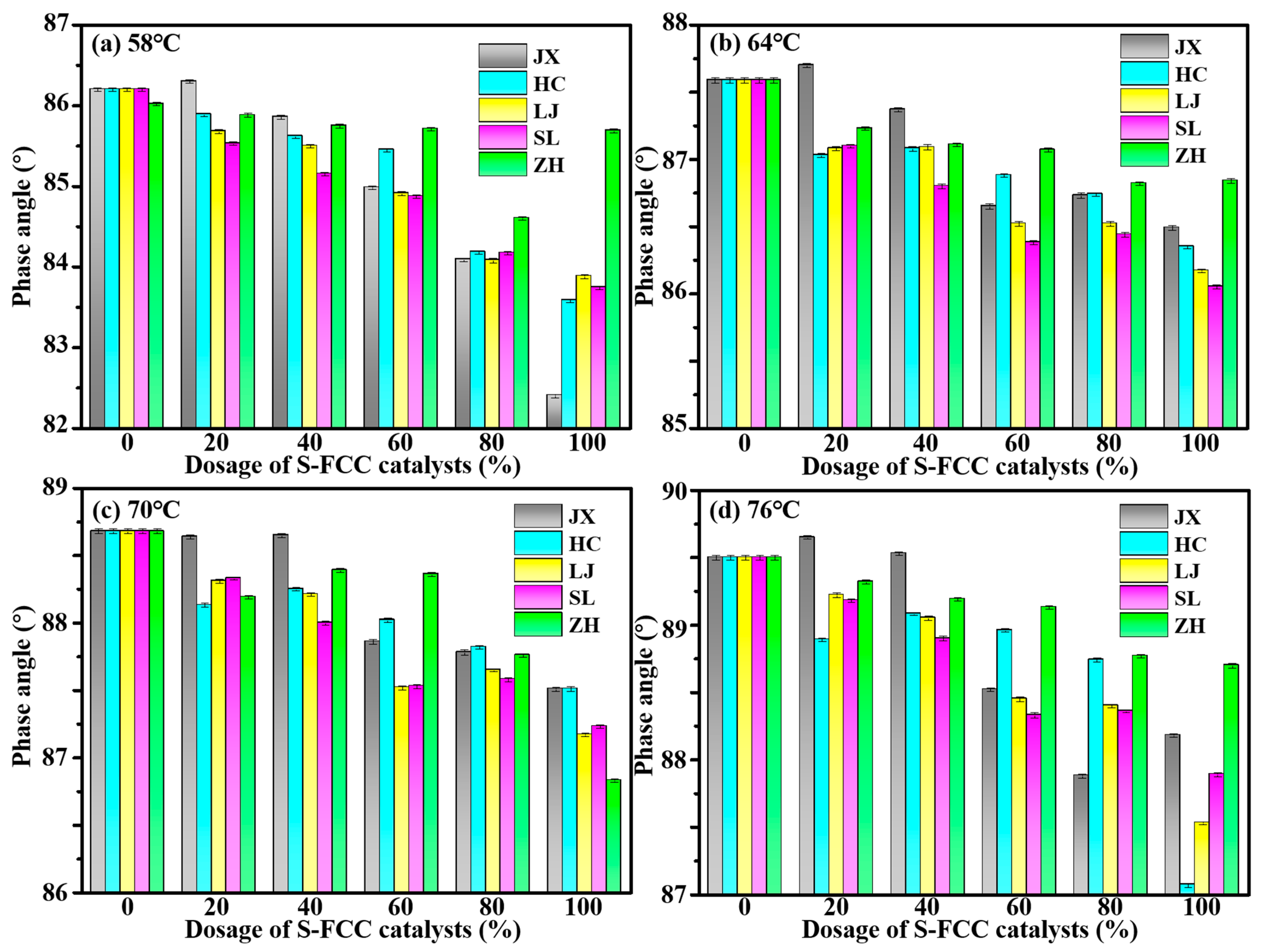



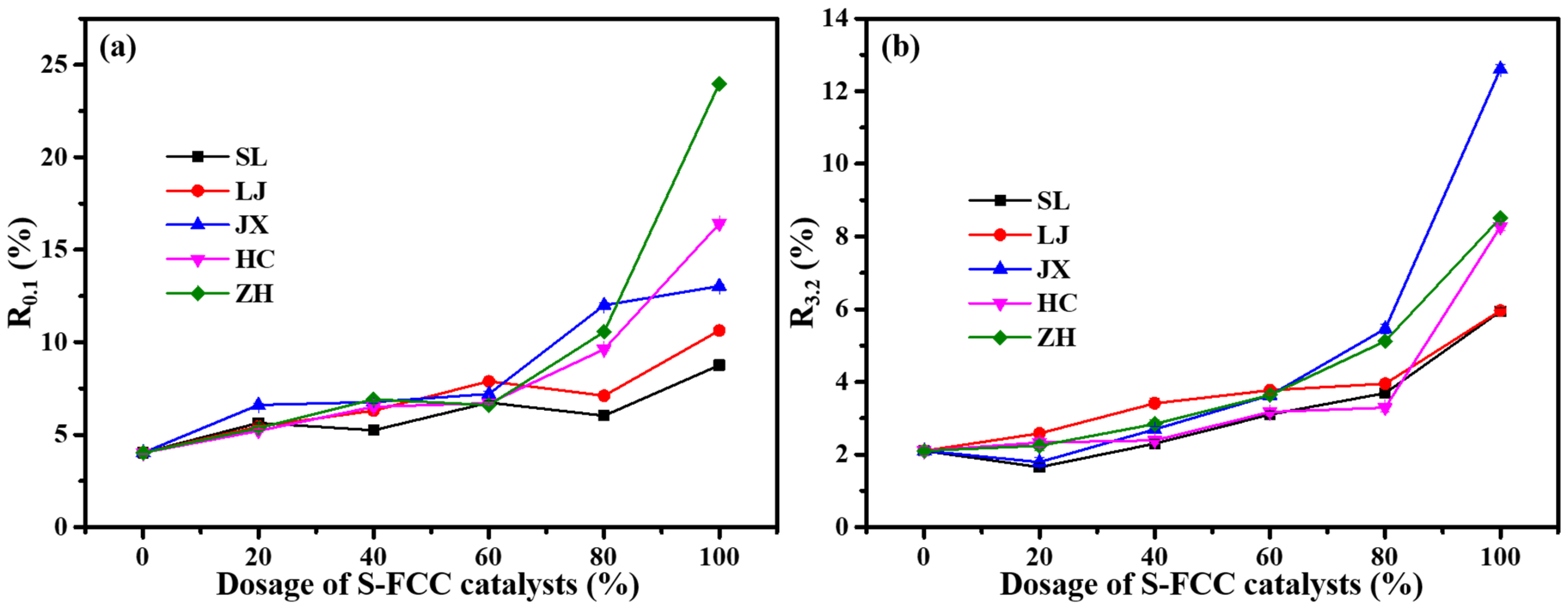
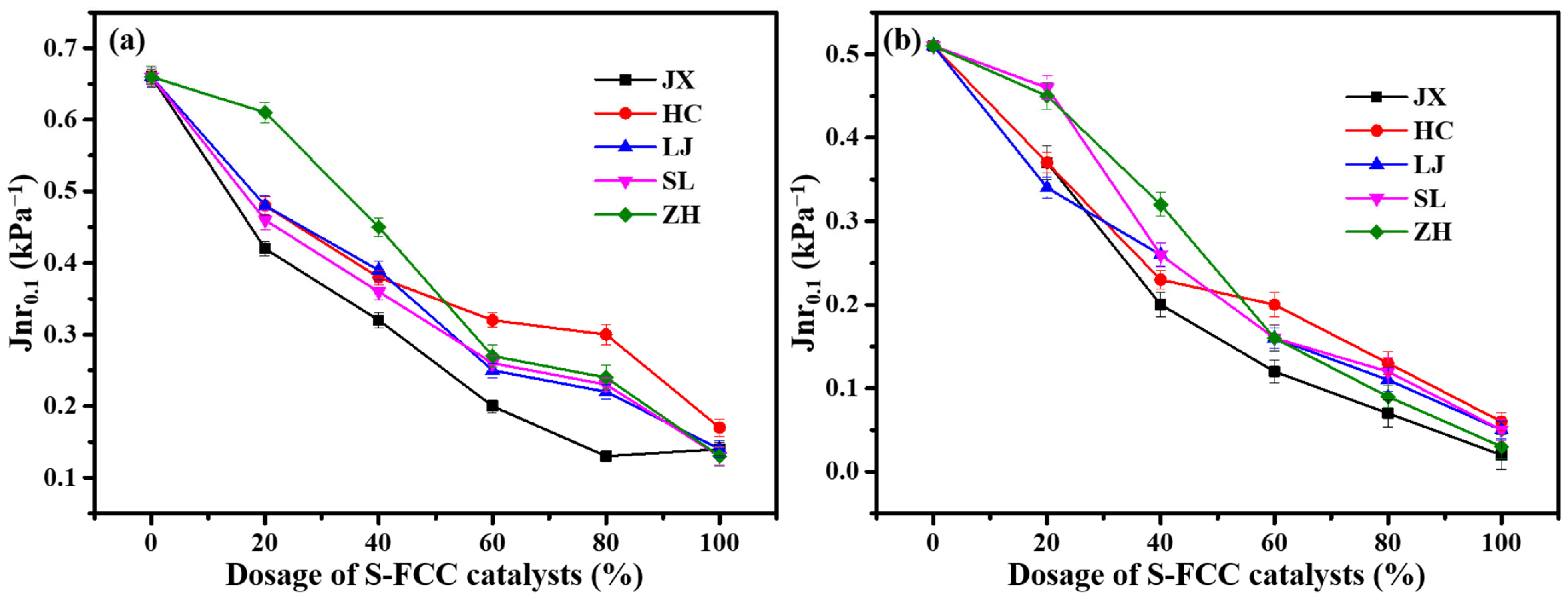

| Raw Materials | Specific Surface Area (m2/g) | Hydrophilic Coefficient | Density (g/m3) |
|---|---|---|---|
| JX | 105 | 1.016 | 2.630 |
| HC | 84 | 0.538 | 2.520 |
| LJ | 103 | 0.967 | 2.645 |
| SL | 117 | 1.124 | 2.485 |
| ZH | 109 | 0.700 | 2.689 |
| Mineral powder | 1.286 | 0.700 | 2.650 |
| Technical Specifications | Unit | Test Results |
|---|---|---|
| Needle penetration (25 °C) | 0.1 mm | 65.8 |
| Needle penetration index PI | / | −1.2 |
| Latency (10 °C) | cm | 25 |
| Latency (15 °C) | cm | >100 |
| Softening point | °C | 47.5 |
| Flash Point | °C | 320 |
| Wax content | % | 1.3 |
| 60 °C power viscosity | Pa.s | 223 |
| Density (15 °C) | g/cm3 | 1.04 |
| Quality change | % | −0.33 |
| Residual needle penetration ratio after TFOT | % | 63.5 |
| Residual latency (15 °C) | cm | 8.5 |
| Powder Type | Jnr (0.1) and Doping Fitting Function | R2 |
|---|---|---|
| ZH | y = 0.68786 − 0.00661x + 0.0000982143x2 | 0.970 |
| LJ | y = 0.65214 − 0.00833x + 0.0000330357x2 | 0.990 |
| SL | y = 0.64214 − 0.00840x + 0.0000348214x2 | 0.983 |
| JX | y = 0.64964 − 0.01124x + 0.0000611607x2 | 0.992 |
| HC | y = 0.63679 − 0.00690x + 0.0000254464x2 | 0.961 |
| Powder Type | Jnr (3.2) with Doping Fitting Function | R2 |
|---|---|---|
| ZH | y = 0.50214 − 0.00629x + 0.0000151786x2 | 0.978 |
| LJ | y = 0.49893 − 0.00741x + 0.0000299107x2 | 0.993 |
| SL | y = 0.53643 − 0.00730x + 0.0000241071x2 | 0.968 |
| JX | y = 0.51536 − 0.00905x + 0.0000415179x2 | 0.995 |
| HC | y = 0.50179 − 0.00710x + 0.0000281250x2 | 0.984 |
Disclaimer/Publisher’s Note: The statements, opinions and data contained in all publications are solely those of the individual author(s) and contributor(s) and not of MDPI and/or the editor(s). MDPI and/or the editor(s) disclaim responsibility for any injury to people or property resulting from any ideas, methods, instructions or products referred to in the content. |
© 2023 by the authors. Licensee MDPI, Basel, Switzerland. This article is an open access article distributed under the terms and conditions of the Creative Commons Attribution (CC BY) license (https://creativecommons.org/licenses/by/4.0/).
Share and Cite
Wang, Z.; Kong, L.; He, S. High-Temperature Rheological Properties of Asphalt Mortar Modified with Spent FCC Catalysts. Appl. Sci. 2023, 13, 9376. https://doi.org/10.3390/app13169376
Wang Z, Kong L, He S. High-Temperature Rheological Properties of Asphalt Mortar Modified with Spent FCC Catalysts. Applied Sciences. 2023; 13(16):9376. https://doi.org/10.3390/app13169376
Chicago/Turabian StyleWang, Zhimei, Lingyun Kong, and Shengqing He. 2023. "High-Temperature Rheological Properties of Asphalt Mortar Modified with Spent FCC Catalysts" Applied Sciences 13, no. 16: 9376. https://doi.org/10.3390/app13169376
APA StyleWang, Z., Kong, L., & He, S. (2023). High-Temperature Rheological Properties of Asphalt Mortar Modified with Spent FCC Catalysts. Applied Sciences, 13(16), 9376. https://doi.org/10.3390/app13169376





